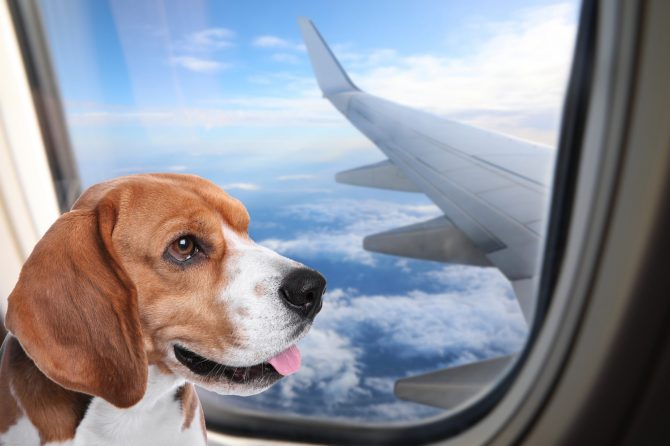
Animals left at airports speaks to the complications of travelling with a pet
Andrea Sachs | The Free Press
In the past few weeks, three dogs and a tortoise arrived with their travel companions at various airports across the United States. By all appearances, the pets were going to fly off with their humans. But at some point between check-in and boarding, their owners decided to leave the animals behind.
One dog was found tied to a pole outside the airport in Des Moines. The tortoise was discovered in a restroom at Harry Reid International Airport in Las Vegas. A puppy was abandoned by a departure gate at the same airport. Another dog was surrendered to airline employees at Charlotte Douglas International, bringing to mind an incident last summer when a young dog was handed over to airline workers in San Francisco.
“This is the wrong thing to do, morally and criminally,” said Joe Stafford, director of animal services with the Animal Rescue League of Iowa, which assisted in the rescue and care of the pit bull that the staff named Allie. “There are a lot of resources that can help owners in any given situation.”

Allie was found tied to a pole outside Des Moines International Airport after her owner abandoned her. She was rescued by the Animal Rescue League of Iowa.
Reports of these orphaned animals surfacing in such quick succession raise an alarming question: How often are people deserting their pets at airports?
“Animal abandonment has been around for a long time, but I don’t think we are in an epidemic of people abandoning their pets at airports,” said Holly Sizemore, chief mission officer with Best Friends Animal Society, an animal welfare nonprofit based in Utah. She shared one reason for the recent attention: “All things airlines have been in the news.”
In each of the aforementioned episodes, the travel community jumped in to help the animals in distress. Passengers and airline personnel joined forces with law enforcement and animal rescue operations to ensure the safety of the dogs — Allie, Penny, Polaris and Baby Girl — and Boeing the tortoise.
The majority of pet owners probably won’t leave their animals anywhere, anyhow. “Most people who travel with their pets are prepared and want their pets with them every step of the way,” said Laura Sheehan, senior vice president of communications and legislative affairs with American Humane in Arlington, Va.
However, flying with a four-legged friend requires an extra degree of preparation. The stories of the four dogs and the tortoise are more than morality plays; they are instructive examples of how failing to take the proper steps before traveling with a pet can leave you both in a bind. Here are some takeaways from their tales.
Read the airline’s rules for pets
Travel requirements for pets vary among airlines and countries, and protocols have changed during the coronavirus pandemic.
For example, U.S. carriers stopped allowing emotional support animals in the cabin in 2021. The same year, the Centers for Disease Control and Prevention temporarily suspended the importation of dogs from countries with a high risk of rabies. Polaris, the puppy surrendered at the San Francisco airport in August, had flown in from China, one of the countries on the list.
“It’s not just the airlines; it’s where you’re going, too. What are they allowing?” said Kelly Donithan, director of global animal disaster response with Humane Society International. “It all depends on the airline, the route and the destination.”
Start your research with the airline’s website, which will cover the carrier’s requirements, such as crate specs, breed restrictions, age minimums and cost, as well as country-specific regulations related to flying.
Airlines limit the number of animals permitted in the cabin, so make arrangements for your pet at the same time you book your own ticket. Carriers may not allow pets to fly in cargo during certain months or hours when the risk of extreme temperatures is high.
Choose the appropriate pet carrier
Two of the recent incidents involved issues with pet carriers. In Charlotte, Baby Girl’s case was too large to slide under the seat. The owner could not afford the cargo transport fees, so she surrendered her senior beagle mix to an airline agent.
Allie’s owner showed up at the Des Moines airport with only a leash and harness, according to Stafford. The Newark-bound traveller had (wrongly) assumed the airline would supply the gear. However, Stafford said, the owner could have contacted a shelter for assistance.
The correct dimensions are critical. The animal must also fit comfortably inside. They should be able to lie down, stand up and turn around without bumping into the walls or roof. Their ears should not touch the top, either.
Make your contact information clear
Ensure that your pet is microchipped and that the contact details are current. For an extra level of assurance, affix your contact information to the carrier or scrawl your details on the case with a Sharpie pen.
Penny’s only identifying accessory was a heart-shaped name tag. With little else to go on, the Animal Foundation in Las Vegas could not track down the 9-week-old puppy’s owners. Allie did not have identification, either. Stafford said they located her owner through airport security cameras.
Also ask: Is your pet fit to travel?
Before you consider travelling with your pet, you should ask yourself a few questions. Does your pup (or cat or reptile) like new people and places? Are they bothered by the squeak of bag wheels and the hum of plane engines?
If your pet is shy, anxious or scared of unfamiliar noises and strangers, they will probably prefer a staycation with a sitter or an overnight at a boarding facility.
Storybook endings
The journeys of Polaris, Allie, Penny, Baby Girl and Boeing took unexpected detours, but all ended well.
In December, a United pilot based in San Francisco adopted Polaris. Penny and Boeing are living the Vegas life in their new homes. FurBabies Animal Rescue, a local rescue group, placed Baby Girl in foster care and is raising funds to cover her medical expenses, including dental work.
Allie’s story has a happy ending, too. At the Des Moines airport, a couple had played with the 1-year-old pup in the check-in line and noticed her owner exit the terminal. Unbeknown to them, they flew with Allie on the same Newark flight.
After their trip, they learned of Allie’s travails and contacted the rescue league to inquire about adopting her. Because the owner had relinquished his rights to the dog, she was available. The Des Moines police department issued a warrant for the owner with a charge of abandonment of animals and failure to care for animals, both misdemeanors.
“To them and to me, I feel like she’s in her new forever home,” Stafford said.
Another couple who had met Allie on that fateful day also inquired about adopting her. Because she was already taken, Stafford found them another dog. One abandonment begot two adoptions.
This article originally appeared on The Winnipeg Free Press: People are abandoning pets at airports
Leave a reply





